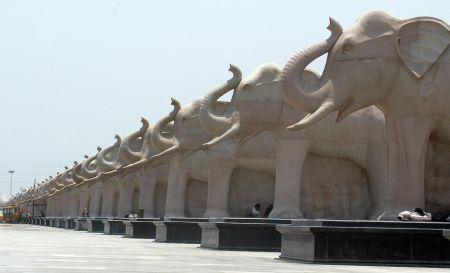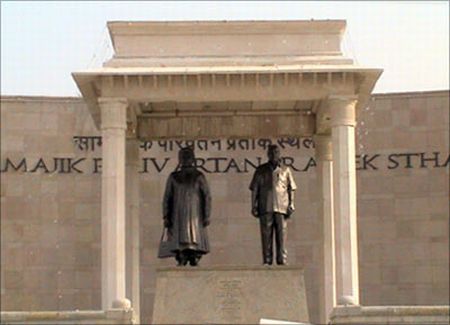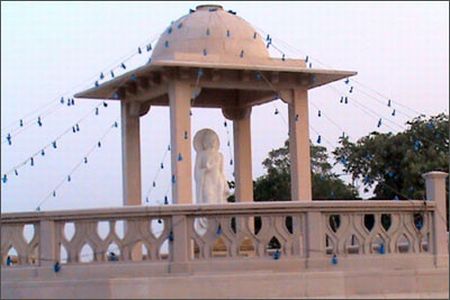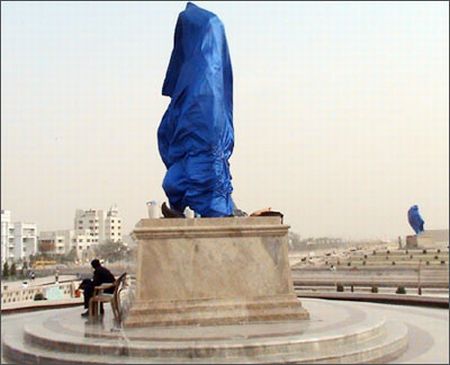Photographs: Pawan Kumar/Reuters Kishore Singh with VS Rawat in Lucknow and Anand Sankar in Delhi/Noida
Queen Maya had not become pregnant despite 20 years of being married to King Suddhodana, the ruler of the Sakya clan of Kapilavastu (in modern Bihar), till she dreamed of a white elephant, interpreted by the court astrologers as heralding the birth of an enlightened being.
In time, Queen Maya gave birth to Siddharth, who would later become the Buddha, the enlightened one who would introduce the subcontinent to Buddhism. Two-and-a-half thousand years later, it's difficult to escape the irony of that story. Not too far from Kapilavastu, in modern-day Lucknow, capital of Uttar Pradesh, a different Maya is in charge.
Her party symbol is the elephant, and the Dalits who were responsible for her spectacular seizure of the coveted chief ministership of the state have converted to Buddhism in large numbers to escape the karma of untouchability, and Mayawati has rechristened the sprawling suburb of Noida, adjoining Delhi, Gautam Budh Nagar.
It is another matter that in Sanskrit, maya means illusion, and in a sleight of Mayawati's treasury accounts, development projects across the state are taking Ozymandian shape as parks and museums and memorials, cenotaphs and statuary, in possibly India's largest infrastructure-building exercise as thousands of stone carvers and masons, tonnes of dholpur and mirzapur stone and hundreds of statue makers have found employment to build, in an extremely short time, shrines to commemorate centuries of Dalit oppression.
Powered by'She wants to leave behind indestructible evidence of her reign'
Image: Statues of Mayawati and her mentor Kanshi Ram at the Samajik Parivartan Pratik Sthal in LucknowPhotographs: Hitesh Harisinghani
Lucknow has not seen building of this order since the reign of Nawab Asaf-ud-Daula, whose contribution to the city was its imambaras; Delhi had commissioned the imperial capital in the 1930s, and though a succession of public buildings has since been part of its landscape, it has seen nothing of the likes of the park-cum-museum that is fast nearing completion on the banks of the Yamuna in Noida.
Nor is there any information on these 'beautification' projects, with nobody in government and even less the man on the street willing to disburse information or disabuse Mayawati's authoritarianism in spearheading them.
In the absence of civic authorities sharing news, the rumour mills have been churning overtime -- two of the domes in Lucknow's vihara-like buildings will be the largest in India; no, the dome over Noida's memorial structure will be the largest in Asia; 2,500 masons are working on the projects in Lucknow alone, some 25,000 workers are employed across different states to fulfill her insatiable appetite; just the cost of work in Lucknow will exceed Rs 6,000 crore, say some; and the number of Mayawati statues will outnumber those of dalit leader B R Ambedkar and her mentor Kanshi Ram What is evident is a growing disenchantment at money spent not to build infrastructure or improve lives, but to carve a place in the nation's memory for Mayawati.
It is for that reason that no one is allowed to question these buildings that spread over thousands of acres. Built ostensibly for people -- Dalits or others -- they may not be overtly ostentatious (though the scale is grand), but they are as inescapable as they are exclusionist with their high boundary walls that are not merely forbidding in appearance, they turn away curious onlookers with stern warnings.
Powered byQueen Maya's writ runs strong
Image: A Buddha statue in LucknowPhotographs: Hitesh Harisinghani
The modern Queen Maya's writ runs strong despite a poorer showing than expected at the national hustings.
It may have dulled some of the veneer from the controversial BSP headquarters that has come up in snobbish Chanakyapuri where the chief minister purchased Urdu publisher Yunus Dehlvi's house, then demolished it to build a stately but surprisingly sedate set of twin buildings bridged by a life-size sandstone elephant. The elephant is a recurring motif in her architecture, a blend of Indian and European with elements that are Roman, Corinthian, Hindu, Muslim and Buddhist that manage to look no more offensive than many of the city's more prominent houses, but there's no escaping the nod to the commanding heights of architecture.
So must rulers in the past have considered their lofty ambitions; so must Mayawati be translating hers. At the 'smaraks' and 'sthals' in Lucknow, rows of stone elephants act as heralds; at her brother's home in Noida, golden elephants march across the forbidding gates, and in the park in Noida, avenues of 300-ft high pillars are crowned by four-headed elephants. Buddhist motifs are extensively used in walls and parapets and facades of Maya's structures in Uttar Pradesh, and in Delhi, there is a nod towards elements from Lutyens's 'jaalis' and emblems.
Powered by'Lucknow can't be turned into city of statues'
Image: Statues of Ambedkar and his wife Ramabai, which face Maya's statue at the Samajik Parivartan SthalPhotographs: Hitesh Harisinghani
Yet, Mayawati's many statues both across Lucknow and in Noida are currently more like shrouds, positioned in alcoves and on pedestals but completed swathed in layers of plastic sheets, no doubt to be unveiled with due pomp and ceremony at some date in the future when her fantasy projects are complete.
With the looming threat of tax increases, the mayor adds, "I do not think it is prudent on the part of anyone to spend such colossal amounts on such activities when you cannot provide proper civic amenities. It shows that the priorities of the UP government are not right." Former Geological Survey of India director and environmental activist V K Joshi complains, "We need green parks, not parks made of concrete and sandstone." But who will tell Mayawati that? "It is sad that even the environmentalists are mum for fear of reprisal," says Lucknow MP Lalji Tandon.
Powered by ![]()
'It seems like a mad queen's folly, an exercise in excess'
Image: Mayawati's statue shrouded in blue clothPhotographs: Hitesh Harisinghani
At one time Delhi-based artist and architect Satish Gujral's name was associated with some buildings in Mayawati's first tenure as chief minister, but was later withdrawn when they were torn down to make way for yet larger structures. It is this obsession to make and then re-make that has had tongues wagging in Lucknow. Yet, Mayawati has managed to ride out any protests, a tribute to her invincibility.
Not everyone is as critical, of course -- not the thousands of quarry workers and carvers and statue makers, and almost certainly not the hundreds of thousands of Dalits who see their empowerment not just in economic terms but in these architectural monuments to their rising domination in politics. Sculptor Shravan Prajapati endorses the emblematic construction, saying it is "a message to the Dalits" and will "help the backwards know their history".
Yet, it seems like a mad queen's folly, an exercise in excess. There appears to be no shortage of funds, tardy executives are rapidly shunted from office, stone dust and rubble are spread across hundreds of acres as the new empire is shaped in tribute to her uncouth majesty. Under the haze, a sense of powerful buildings is evident, and perhaps in time visitors from around the world will come to gaze at these marvels, even if they appear somewhat preposterous at this turn of a new century. By then, of course, Mayawati's grand palaces will be little more than mausoleums to her memory. But that, perhaps, is just what Queen Maya of the Dalits wants.
| THE HOUSE(S) THAT MAYAWATI BUILT IN LUCKNOW Kanshi Ram Smarak, Jail Road, 70 acres watch out for its 141-ft high stupa Ramabai Rally Sthal, near Ambedkar University, currently 50 acres but to be spread over 150 acres at the expense of several villages, schools and hospitals Samta Moolak Chauraha, Gomti Nagar, an intersection and stone pachyderm-lined promenade leading to the river Gomti Buddha Vihar, VIP Road, built over 25 acres after 400 houses were demolished Smriti Upvan, Bangla Bazaar IN NCR BSP House, in Chanakyapuri, where the lack of opulence might be a nod to fit in with the old money neighbourhood Sector 44 house in brother Anand Kumar's name, a crass display of wealth in a modest neighbourhood |






article